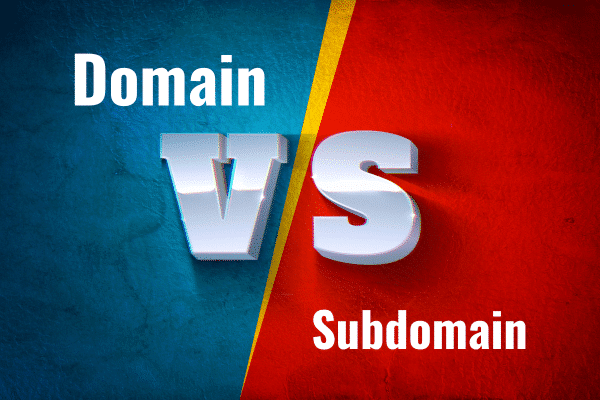- 619-846-5963
- Book A Discovery Call
- [email protected]
- 830 Kuhn Dr. Suite 210725, Chula Vista CA, 91921

In the ever-expanding realm of the internet, where over 1.8 billion websites vie for attention, the decisions we make about our online presence carry profound consequences. Many of the sites opted for subdomains to organize their content and services.
Deciding between a domain vs. a subdomain plays a pivotal part in digital identity but also the user experience they offer. Making this choice will have profound impacts on your business going forward.
In this exploration, we delve into the critical decision-making process between the two approaches. We examine their impacts on branding and the intricacies of user interactions in the digital realm. Keep reading to learn all about them.

When establishing an online presence, one of the pivotal decisions you’ll face is how to structure your web addresses. This choice boils down to using a domain vs. a subdomain. Each approach has distinct advantages and considerations, so choose wisely.
You can always run an A/B test, too, for different businesses. Over time, you’ll gain a greater perspective on what works for you and what doesn’t. You’re always free to switch up your strategy as your company grows as well.
A domain is the human-readable address people use to find, identify, and access a site. It’s part of a website’s URL (Uniform Resource Locator).
Domains comprises two main components: domain name and domain extension.
A domain name is a user-friendly text-based name you type into your web browser’s address bar to visit a site. For example, in the URL “ascendancewebsitesolutions.com”, “ascendancewebsitesolutions” is the domain name.
Domain extensions or top-level domain (TLD) is what comes after a domain name and usually indicates the type or purpose of the website. Common TLDs include “.com,” “.org,” “.net,” “.gov,” and “.edu.”.
In the example “ascendancewebsitesolutions.com,” the “.com” is the TLD.
Using your main domain exclusively can help maintain a consistent and cohesive brand image. Visitors instantly recognize your brand when they see your domain name, reinforcing brand familiarity and trust.
Search engines tend to favor main domains because they typically contain your primary keywords and offer a clear indication of your site’s focus. This can positively impact your search engine ranking.
Users don’t need to navigate through multiple web addresses, making it easier for them to find the information they’re looking for. A simple, intuitive structure can enhance the overall user experience.
Remember that when you have one main domain, all of your backlinks will go to it. This is much easier to build domain authority and see if your SEO is working or not
If you want a much simpler solution for SEO, go with a single domain. When you use subdomains, you’ll be simultaneously creating more work for your staff. When you’re just starting, this means time and money.
If you want a much simpler solution for SEO, go with a single domain. When you use subdomains, you’ll be simultaneously creating more work for your staff. When you’re just starting, this means time and money.
One of the disadvantages of using just a single primary domain is that you have a diverse range of content or services. You may find it difficult to organize them neatly, as it can lead to a cluttered interface and a less intuitive experience.
Scalability is something you’ll also want to keep in mind if you go the solo domain route. As you expand the scope of your site, it can become complex on how you’ll organize it all.
Subdomains offer a more versatile approach, allowing you to categorize and segregate different sections of your website. Let’s take a closer look at their implications and challenges.

Subdomains are like mini-websites under your main domain. Each is capable of having its unique content, design, and functionality. This versatility can cater to various user needs and enhance user experience by providing specialized areas for different purposes.
Subdomains are useful for creating specialized sections like blogs (blog.yourdomain.com), e-commerce stores (store.yourdomain.com), support portals (support.yourdomain.com), and more.
As your website grows, subdomains can facilitate expansion without overwhelming your primary domain. Each subdomain can serve as a dedicated space for specific content or services. This makes it easier to manage and navigate going forward.
Your brand may cover a wide range of topics. You may provide a lot of different products for various audiences. You can improve your company branding with a subdomain since you can compartmentalize each topic.
This is highly helpful for things like SEO, keywords, and the value you provide.
You may have clients and customers from all corners of the world. For this reason, a subdomain comes in handy since you’ll be able to target certain geographical demographics. Before you know it, you’ll be ranking higher in local searches.
One way to improve the user experience is via subdomaining. If you think of it from a user perspective, one domain can make things more challenging to navigate.
Your site hierarchy will make much more sense with subdomains. Not to mention, it’ll cut down bounce rates and improve your overall SEO performance.
Search engines treat subdomains as separate entities. This can lead to some SEO challenges. The domain authority is distributed across multiple subdomains.
It’s crucial to optimize each subdomain individually and ensure they link effectively to maintain SEO effectiveness.
Using too many subdomains without a clear organizational strategy can confuse users and dilute your brand’s identity. It’s essential to strike a balance between versatility and maintaining a cohesive brand image.

The choice between a domain vs. a subdomain is your decision and should align with your brand identity and user experience objectives. By understanding the impact of this choice, you can build a robust online presence that resonates with your audience and supports your digital goals.
Whichever you choose, just know that you’re not alone in the process. If you want to take your business to the next level, contact Ascendance Website Solutions.
We’ll help you every step of the way in building your brand from the ground up. We’re looking forward to hearing from you.

Ascendance is proud to offer a 10% discount for any business owner or entrepreneur who is current or former military or a first responder. This extends to family as well so if you have a family member that is current or former military or a first responder you will still receive the 10% discount for as long as you work with Ascendance!
Thank you all for your incredible service for our country and keeping us safe!